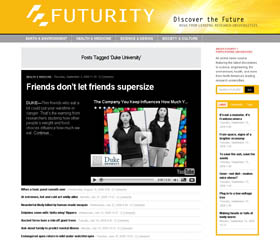
A group of leading research universities has launched Futurity (www.futurity.org), an online research channel covering the latest discoveries in science, engineering, the environment, health, and more.
The site offers direct access to research news posted by Duke University and 35 partners supporting the project.
Futurity cofounder Michael Schoenfeld, vice president for public affairs and government relations at Duke, says the site allows the public to see how federal, state, and private funds are being put to use by universities to address critical challenges.
"It's not often you see high-powered universities working together in such a collaborative way," says Schoenfeld. "That fact alone indicates the project's significance. Universities are the world's laboratories. They host the brightest minds working to answer some of today's most urgent questions. The breadth and caliber and the collective force of the research featured on Futurity is truly extraordinary."
James Grant, executive director of media relations at USC, says Futurity offers the public direct access to exciting research breakthroughs. "There are no ads, no interruptions, and no agenda. It's research that makes you go ‘Wow!' And, you don't have to be a molecular biologist to enjoy it."
Grant expects Futurity to have a broad appeal. "There's nothing quite like it on the Web. I think once people visit the site, they'll be hooked. It's the kind of news you'll want to forward to a friend. You'll feel smarter just for visiting."
Bill Murphy, one of Futurity's cofounders and vice president for communications at the University of Rochester, says universities are affected by the challenges facing newspapers today. News holes are shrinking, he notes, and coverage of research-related stories has been hit particularly hard.
"In light of this shifting news landscape, universities are looking for ways to share important breakthroughs with the public. Futurity gives our partners an opportunity to communicate in a new and direct way and to remind the public why research matters."
All of the stories on Futurity are edited to stir the imagination, says Murphy. "We want the stories to engage readers, to raise questions, and to make readers want to learn more and to come back for more."
Since launching a beta version in March, Futurity has continued to add membership and readership.
Lisa Lapin, assistant vice president for communications at Stanford University, says Futurity is looking for new ways to extend the site's reach. "We're active on Twitter, Facebook, and YouTube. We're also in partnership talks with major Internet news providers. Today's online environment is perfectly suited for this type of direct communication. There's something very authentic about universities working together to share knowledge."
Lapin says the site is designed to encourage interaction. Stories include links to published reports and supplemental materials that allow readers to explore topics in more detail. The site is available in a mobile friendly version, and visitors can comment on stories and sign up for a daily e-mail update.
Duke, like all the current partner universities, is a member of the Association of American Universities (AAU), a nonprofit organization of leading public and private research universities. Lapin says Futurity may revisit membership criteria down the road but needs to keep the numbers manageable while they fine-tune the approach.
Futurity has featured a number of stories and videos about Duke scientists in recent weeks, including a report on giant lightening strikes going straight up to the edge of space and the subtle influence on food portions that your dining partners exert on you.
"Futurity creates a space where universities can share fascinating, thought-provoking ideas," adds Grant. "It builds a bridge between the scientific community and the larger world. Really, it gets to the heart of what all great universities do best: educate and inform."